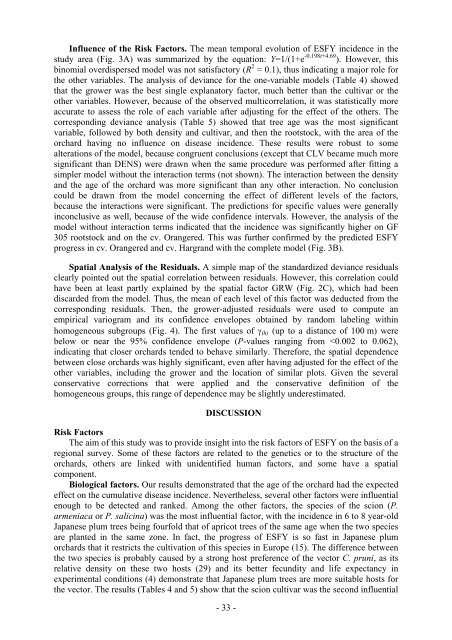Ecole Nationale Supérieure Agronomique de Montpellier ... - CIAM
Ecole Nationale Supérieure Agronomique de Montpellier ... - CIAM
Ecole Nationale Supérieure Agronomique de Montpellier ... - CIAM
Create successful ePaper yourself
Turn your PDF publications into a flip-book with our unique Google optimized e-Paper software.
Influence of the Risk Factors. The mean temporal evolution of ESFY inci<strong>de</strong>nce in the<br />
study area (Fig. 3A) was summarized by the equation: Y=1/(1+e -0.198t+4.69 ). However, this<br />
binomial overdispersed mo<strong>de</strong>l was not satisfactory (R 2 = 0.1), thus indicating a major role for<br />
the other variables. The analysis of <strong>de</strong>viance for the one-variable mo<strong>de</strong>ls (Table 4) showed<br />
that the grower was the best single explanatory factor, much better than the cultivar or the<br />
other variables. However, because of the observed multicorrelation, it was statistically more<br />
accurate to assess the role of each variable after adjusting for the effect of the others. The<br />
corresponding <strong>de</strong>viance analysis (Table 5) showed that tree age was the most significant<br />
variable, followed by both <strong>de</strong>nsity and cultivar, and then the rootstock, with the area of the<br />
orchard having no influence on disease inci<strong>de</strong>nce. These results were robust to some<br />
alterations of the mo<strong>de</strong>l, because congruent conclusions (except that CLV became much more<br />
significant than DENS) were drawn when the same procedure was performed after fitting a<br />
simpler mo<strong>de</strong>l without the interaction terms (not shown). The interaction between the <strong>de</strong>nsity<br />
and the age of the orchard was more significant than any other interaction. No conclusion<br />
could be drawn from the mo<strong>de</strong>l concerning the effect of different levels of the factors,<br />
because the interactions were significant. The predictions for specific values were generally<br />
inconclusive as well, because of the wi<strong>de</strong> confi<strong>de</strong>nce intervals. However, the analysis of the<br />
mo<strong>de</strong>l without interaction terms indicated that the inci<strong>de</strong>nce was significantly higher on GF<br />
305 rootstock and on the cv. Orangered. This was further confirmed by the predicted ESFY<br />
progress in cv. Orangered and cv. Hargrand with the complete mo<strong>de</strong>l (Fig. 3B).<br />
Spatial Analysis of the Residuals. A simple map of the standardized <strong>de</strong>viance residuals<br />
clearly pointed out the spatial correlation between residuals. However, this correlation could<br />
have been at least partly explained by the spatial factor GRW (Fig. 2C), which had been<br />
discar<strong>de</strong>d from the mo<strong>de</strong>l. Thus, the mean of each level of this factor was <strong>de</strong>ducted from the<br />
corresponding residuals. Then, the grower-adjusted residuals were used to compute an<br />
empirical variogram and its confi<strong>de</strong>nce envelopes obtained by random labeling within<br />
homogeneous subgroups (Fig. 4). The first values of γ(h) (up to a distance of 100 m) were<br />
below or near the 95% confi<strong>de</strong>nce envelope (P-values ranging from



